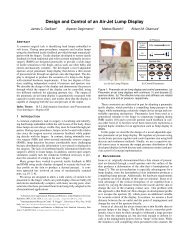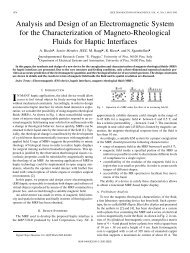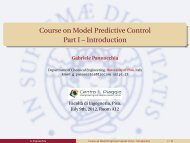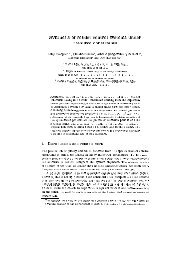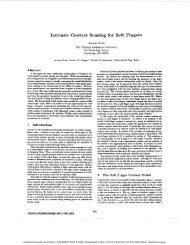Synergyâbased Optimal Design of Hand Pose ... - Centro E Piaggio
Synergyâbased Optimal Design of Hand Pose ... - Centro E Piaggio
Synergyâbased Optimal Design of Hand Pose ... - Centro E Piaggio
You also want an ePaper? Increase the reach of your titles
YUMPU automatically turns print PDFs into web optimized ePapers that Google loves.
gradient flow (10) onto the subspace tangent to the constraint,obtaining the search directions = ∇‖P p ‖ 2 FW . (11)Having the search direction for the constrained problem,the gradient flow is given byḢ = −4 [ P 2 pP o H T Σ(H) ] TW (12)where Σ(H) = (HP o H T +R) −1 . The gradient flow (10) guaranteesthat the optimal solution H ∗ has unit vectors as rows,if H(0) satisfies the latter condition.In [15] authors define a function V 2 (P) with P ∈ IR n×nthat forces the entries <strong>of</strong> P to be as “positive” as possible.In this section, for the second gradient, we extend thisfunction to measurement matrices H ∈ IR m×n with m < n,thus considering function V 2 : O m×n → IR, given byV 2 (H) = 2 3 tr[ H T (H − (H ◦ H)) ] , (13)where A ◦ B denotes the Hadamard or elementwise product<strong>of</strong> the matrices A = (a i j ) and B = (b i j ), i.e. A ◦ B = (a i j b i j ).The gradient flow <strong>of</strong> V 2 (H) isḢ = −H [ (H ◦ H) T H − H T (H ◦ H) ] , (14)which minimizes V 2 (H) converging to a matrix in P m×n ifH(0) ∈ O m×n (H(0) is the starting point at t = 0 for (14)).By combining (12) and (14), we can build the followinggradient flowḢ c,d = 4(1 − k) [ P 2 pP o H T c,d Σ(H c,d) ] TW++ k ¯H d[( ¯H d ◦ ¯H d ) T ¯H d − ¯H T d ( ¯H d ◦ ¯H d ) ] , (15)where k ∈ [0, 1] is a positive constant, Σ(H c,d ) =(H c,d P o Hc,d T + R)−1 , W = I n − Hc,d T (H c,dHc,d T )−1 H c,d is theprojecting matrix onto the set <strong>of</strong> all matrices whose rows areunit vectors, and, finally, ¯H d assumed the following form:[ ]0mc ×n¯H d = .H dThe gradient flow defined in (15) converges towards ahybrid sensing device, i.e. with both continuous and discretesensors, if H c,d (0) ∈ O m×n , minimizing the squaredFrobenius norm <strong>of</strong> the a posteriori covariance matrix. Noticethat, since this problem is not convex, we can only assurethat the proposed algorithm converges to a local minimum.To overcome this common problem in gradient methods aclassic solution can be provided by performing a multi–startsearch.IV. RESULTSFigure 1 shows the values <strong>of</strong> the squared norm <strong>of</strong> thea posteriori covariance matrix for increasing number m <strong>of</strong>measures. In particular, values <strong>of</strong> V 1 for matrices Hc ∗ and Hd∗are reported, for both noise–free and noisy measures. Noticethat, in case <strong>of</strong> noise–free measures, V 1 values decreasewith the number <strong>of</strong> measures, tending to assume nearlyzero values in case <strong>of</strong> both continuous and discrete sensing.This fact is trivial because increasing the measurements wereduce the uncertainty <strong>of</strong> the measured variables. When allV 1(P o,H,R)0.140.120.10.080.060.040.02H * c , R=0H d* , R=0H c* , R≠ 0H d* , R≠ 001 2 3 4 5 6 7 8 9 10 11 12 13 14mFig. 1: Squared Frobenius norm <strong>of</strong> the a posteriori matrixwith noise–free and noisy measures (with noise covariancematrix R = diag(12) [ ◦ ]) for both H ∗ c and H ∗ d .the measured information is available V 1 assumes zero valuewith perfectly accurate measures. In case <strong>of</strong> noisy measures,V 1 values decrease with the number <strong>of</strong> measures but, in thiscase, it tends to a value which is larger, depending on thelevel <strong>of</strong> noise.In case <strong>of</strong> free-noise measures, if we analyze how muchV 1 reduces with the number <strong>of</strong> measurements w.r.t. the valueit assumes for only one measure, reduction percentage withthree measures is greater than 80% for both H ∗ c and H ∗ d .This result suggests that with only three measurements theoptimal matrix can furnish more than 80% <strong>of</strong> uncertaintyreduction. This is equivalent to say that a reduced number <strong>of</strong>measurements is sufficient to guarantee a good hand postureestimation. In [4], [13], under the controllability point <strong>of</strong>view, authors state that three postural synergies are crucial ingrasp pre–shaping as well as in grasping force optimizationsince they take into account for more than 80% <strong>of</strong> variance ingrasp poses. Here, the same result can be obtained in terms<strong>of</strong> the measurement process, i.e. from the observability point<strong>of</strong> view: a reduced number <strong>of</strong> measures coinciding with thefirst three principal components enables for more than 80%reduction <strong>of</strong> the squared Frobenius norm <strong>of</strong> the a posterioricovariance matrix.V. EXPERIMENTSIn this work, we deal with the problem <strong>of</strong> hand posereconstructions considering noisy measures in the discretesensing case. We consider an additional zero–mean randomGaussian noise with standard deviation <strong>of</strong> 7 ◦ on each measureand hence a noise covariance matrix R = diag(7) [ ◦ ].This value is chosen in a cautionary manner, based on dataabout common technologies and tools used to measure handjoint positions [17]. Without loss <strong>of</strong> generality we haveadopted the 15 DoF model also in used [4], [13], [5] andreported in figure 3. As described in [5], an optical motioncapture system (Phase Space, San Leandro, CA - USA)with 19 active markers is used to collect a large number <strong>of</strong>static grasp positions, see figure 4. Subject AT (M,26) hasperformed all the grasps <strong>of</strong> the 57 imagined objects describedin [4]; these data have been acquired twice to define a set <strong>of</strong>114 a priori data.





